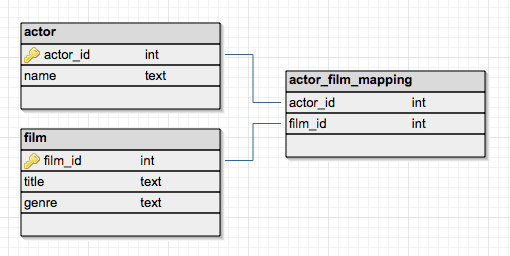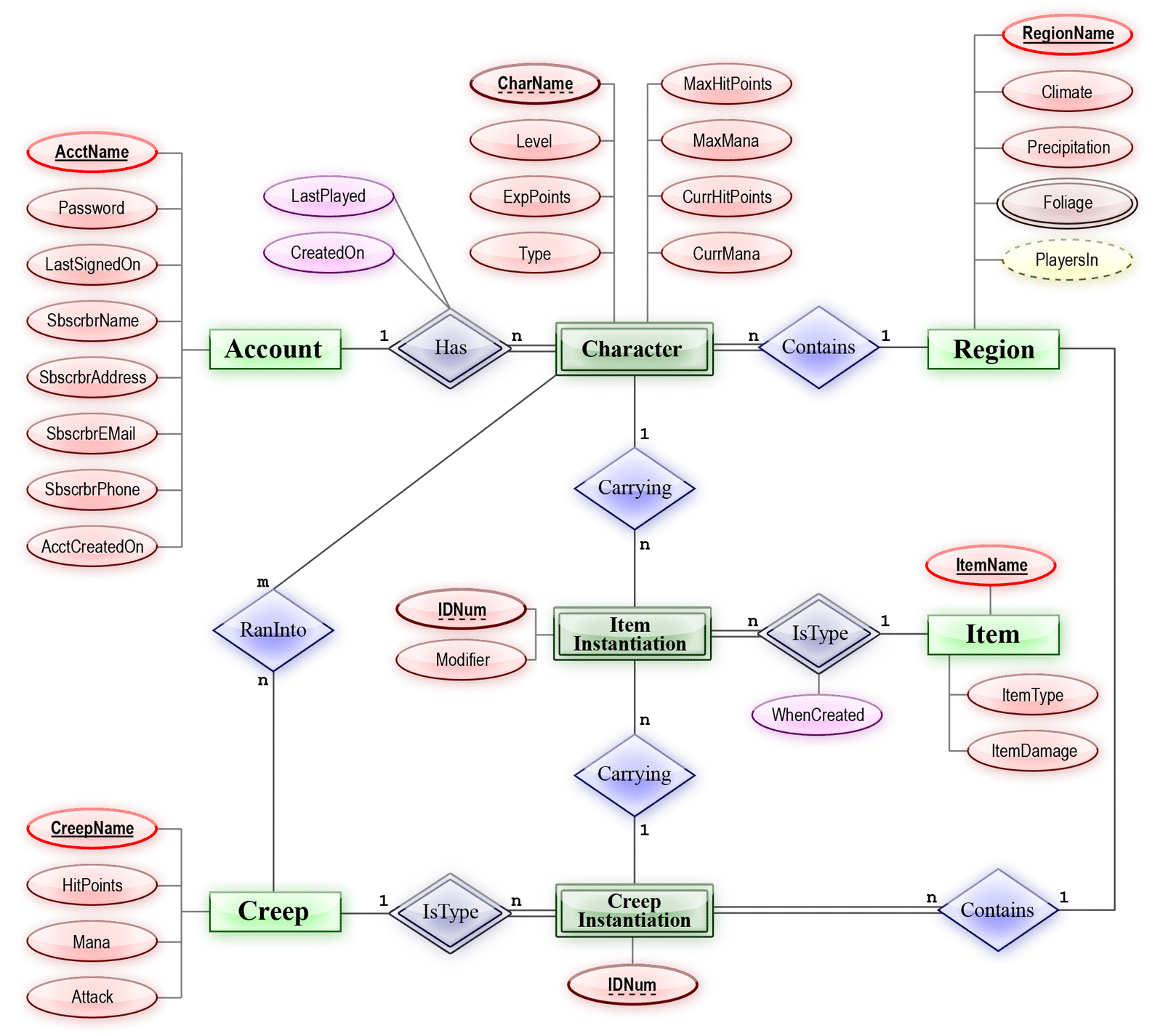|
Associative Entity
An associative entity is a term used in relational and entity–relationship theory. A relational database requires the implementation of a base relation (or base table) to resolve many-to-many relationships. A base relation representing this kind of entity is called, informally, an associative table. As mentioned above, associative entities are implemented in a database structure using associative tables, which are tables that can contain references to columns from the same or different database tables within the same database. An associative (or junction) table maps two or more tables together by referencing the primary keys (PK) of each data table. In effect, it contains a number of foreign keys (FK), each in a many-to-one relationship from the junction table to the individual data tables. The PK of the associative table is typically composed of the FK columns themselves. Associative tables are colloquially known under many names, including association table, bridge t ... [...More Info...] [...Related Items...] OR: [Wikipedia] [Google] [Baidu] |
Relational Model
The relational model (RM) is an approach to managing data using a structure and language consistent with first-order predicate logic, first described in 1969 by English computer scientist Edgar F. Codd, where all data is represented in terms of tuples, grouped into relations. A database organized in terms of the relational model is a relational database. The purpose of the relational model is to provide a declarative method for specifying data and queries: users directly state what information the database contains and what information they want from it, and let the database management system software take care of describing data structures for storing the data and retrieval procedures for answering queries. Most relational databases use the SQL data definition and query language; these systems implement what can be regarded as an engineering approximation to the relational model. A ''table'' in a SQL database schema corresponds to a predicate variable; the contents of a table to ... [...More Info...] [...Related Items...] OR: [Wikipedia] [Google] [Baidu] |
Entity–relationship Model
An entity–relationship model (or ER model) describes interrelated things of interest in a specific domain of knowledge. A basic ER model is composed of entity types (which classify the things of interest) and specifies relationships that can exist between entities (instances of those entity types). In software engineering, an ER model is commonly formed to represent things a business needs to remember in order to perform business processes. Consequently, the ER model becomes an abstract data model, that defines a data or information structure which can be implemented in a database, typically a relational database. Entity–relationship modeling was developed for database and design by Peter Chen and published in a 1976 paper, with variants of the idea existing previously, but today it is commonly used for teaching students the basics of data base structure. Some ER models show super and subtype entities connected by generalization-specialization relationships, and an ER m ... [...More Info...] [...Related Items...] OR: [Wikipedia] [Google] [Baidu] |
Many-to-many (data Model)
In systems analysis, a many-to-many relationship is a type of cardinality that refers to the relationship between two entities, say, A and B, where A may contain a parent instance for which there are many children in B and vice versa. For example, think of A as Authors, and B as Books. An Author can write several Books, and a Book can be written by several Authors. In a relational database management system, such relationships are usually implemented by means of an associative table (also known as join table, junction table or ''cross-reference table''), say, AB with two one-to-many relationships A -> AB and B -> AB. In this case the logical primary key for AB is formed from the two foreign keys (i.e. copies of the primary keys of A and B). In web application frameworks such as CakePHP and Ruby on Rails Ruby on Rails (simplified as Rails) is a server-side web application framework written in Ruby under the MIT License. Rails is a model–view–controller (MVC) fr ... [...More Info...] [...Related Items...] OR: [Wikipedia] [Google] [Baidu] |
Associate Entity
Associate may refer to: Academics * Associate degree, a two-year educational degree in the United States, and some areas of Canada * Associate professor, an academic rank at a college or university * Technical associate or Senmonshi, a Japanese educational degree * Associate of the Royal College of Science, an honorary degree-equivalent award presented by Imperial College London * Teaching associate, an academic teaching position usually requiring a graduate degree * Research associate, an academic research position usually requiring a graduate degree Business * Employee * Business partner * Associate, an independent (often self-employed) person working as if directly employed by a company * Associate company, an accounting and business valuation concept * Coworker, a partner or colleague in business or at work. Health care * Clinical research associate (CRA), a clinical trial monitor which oversees the conduct of clinical trials in study sites and helps protecting stud ... [...More Info...] [...Related Items...] OR: [Wikipedia] [Google] [Baidu] |
Mapping Table Concept
Mapping may refer to: * Mapping (cartography), the process of making a map * Mapping (mathematics), a synonym for a mathematical function and its generalizations ** Mapping (logic), a synonym for functional predicate Types of mapping * Animated mapping, the depiction of events over time on a map * Brain mapping, the techniques used to study the brain * Data mapping, data element mappings between two distinct data models * Gene mapping, the assignment of DNA fragments to chromosomes * Mind mapping, the drawing of ideas and the relations among them * Projection mapping, the projection of videos on the surface of objects with irregular shapes * Robotic mapping, creation and use of maps by robots * Satellite mapping, taking photos of Earth from space * Spiritual mapping, a practice of some religions * Texture mapping, in computer graphics * Web mapping, mapping of data delivered by Geographic Information Systems See also * * * Mapping theorem (other) * Mappings (poetry) * ... [...More Info...] [...Related Items...] OR: [Wikipedia] [Google] [Baidu] |
Primary Key
In the relational model of databases, a primary key is a ''specific choice'' of a ''minimal'' set of attributes (columns) that uniquely specify a tuple (row) in a relation ( table). Informally, a primary key is "which attributes identify a record," and in simple cases constitute a single attribute: a unique ID. More formally, a primary key is a choice of candidate key (a minimal superkey); any other candidate key is an alternate key. A primary key may consist of real-world observables, in which case it is called a '' natural key'', while an attribute created to function as a key and not used for identification outside the database is called a '' surrogate key''. For example, for a database of people (of a given nationality), time and location of birth could be a natural key. National identification number is another example of an attribute that may be used as a natural key. History Although mainly used today in the relational database context, the term "primary key" pre-dates ... [...More Info...] [...Related Items...] OR: [Wikipedia] [Google] [Baidu] |
Foreign Key
A foreign key is a set of attributes in a table that refers to the primary key of another table. The foreign key links these two tables. Another way to put it: In the context of relational databases, a foreign key is a set of attributes subject to a certain kind of inclusion dependency constraints, specifically a constraint that the tuples consisting of the foreign key attributes in one relation, R, must also exist in some other (not necessarily distinct) relation, S, and furthermore that those attributes must also be a candidate key in S. In simpler words, a foreign key is a set of attributes that ''references'' a candidate key. For example, a table called TEAM may have an attribute, MEMBER_NAME, which is a foreign key referencing a candidate key, PERSON_NAME, in the PERSON table. Since MEMBER_NAME is a foreign key, any value existing as the name of a member in TEAM must also exist as a person's name in the PERSON table; in other words, every member of a TEAM is also a PERSON. ... [...More Info...] [...Related Items...] OR: [Wikipedia] [Google] [Baidu] |
Laravel
Laravel is a free and open-source PHP web framework, created by Taylor Otwell and intended for the development of web applications following the model–view–controller (MVC) architectural pattern and based on Symfony. Some of the features of Laravel are a modular packaging system with a dedicated dependency manager, different ways for accessing relational databases, utilities that aid in application deployment and maintenance, and its orientation toward syntactic sugar. The source code of Laravel is hosted on GitHub and licensed under the terms of MIT License. History Taylor Otwell created Laravel as an attempt to provide a more advanced alternative to the CodeIgniter framework, which did not provide certain features such as built-in support for user authentication and authorization. Laravel's first beta release was made available on June 9, 2011, followed by the Laravel 1 release later in the same month. Laravel 1 included built-in support for authenti ... [...More Info...] [...Related Items...] OR: [Wikipedia] [Google] [Baidu] |
Pivot Table
A pivot table is a table of grouped values that aggregates the individual items of a more extensive table (such as from a database, spreadsheet, or business intelligence program) within one or more discrete categories. This summary might include sums, averages, or other statistics, which the pivot table groups together using a chosen aggregation function applied to the grouped values. Although ''pivot table'' is a generic term, Microsoft held a trademark on the term in the United States from 1994 to 2020. History In their book ''Pivot Table Data Crunching'', Bill Jelen and Mike Alexander refer to Pito Salas as the "father of pivot tables". While working on a concept for a new program that would eventually become Lotus Improv, Salas noted that spreadsheets have patterns of data. A tool that could help the user recognize these patterns would help to build advanced data models quickly. With Improv, users could define and store sets of categories, then change views by dragging categ ... [...More Info...] [...Related Items...] OR: [Wikipedia] [Google] [Baidu] |
Junction Table
An associative entity is a term used in relational and entity–relationship theory. A relational database requires the implementation of a base relation (or base table) to resolve many-to-many relationships. A base relation representing this kind of entity is called, informally, an associative table. As mentioned above, associative entities are implemented in a database structure using associative tables, which are tables that can contain references to columns from the same or different database tables within the same database. An associative (or junction) table maps two or more tables together by referencing the primary keys (PK) of each data table. In effect, it contains a number of foreign keys (FK), each in a many-to-one relationship from the junction table to the individual data tables. The PK of the associative table is typically composed of the FK columns themselves. Associative tables are colloquially known under many names, including association table, bridge t ... [...More Info...] [...Related Items...] OR: [Wikipedia] [Google] [Baidu] |
Select (SQL)
The SQL SELECT statement returns a result set of records, from one or more tables. A SELECT statement retrieves zero or more rows from one or more database tables or database views. In most applications, SELECT is the most commonly used data manipulation language (DML) command. As SQL is a declarative programming language, SELECT queries specify a result set, but do not specify how to calculate it. The database translates the query into a " query plan" which may vary between executions, database versions and database software. This functionality is called the "query optimizer" as it is responsible for finding the best possible execution plan for the query, within applicable constraints. The SELECT statement has many optional clauses: * SELECT clause is the list of columns or SQL expressions that must be returned by the query. This is approximately the relational algebra projection operation. * AS optionally provides an alias for each column or expression in the SELECT c ... [...More Info...] [...Related Items...] OR: [Wikipedia] [Google] [Baidu] |
Join (SQL)
A join clause in SQL – corresponding to a join operation in relational algebra – combines columns from one or more tables into a new table. Informally, a join stitches two tables and puts on the same row records with matching fields : INNER, LEFT OUTER, RIGHT OUTER, FULL OUTER and CROSS. Example tables To explain join types, the rest of this article uses the following tables: Department.DepartmentID is the primary key of the Department table, whereas Employee.DepartmentID is a foreign key. Note that in Employee, "Williams" has not yet been assigned to a department. Also, no employees have been assigned to the "Marketing" department. This is the SQL statement to create the above tables: CREATE TABLE department( DepartmentID INT PRIMARY KEY NOT NULL, DepartmentName VARCHAR(20) ); CREATE TABLE employee ( LastName VARCHAR(20), DepartmentID INT REFERENCES department(DepartmentID) ); INSERT INTO department VALUES (31, 'Sales'), (33, 'Engineering'), ... [...More Info...] [...Related Items...] OR: [Wikipedia] [Google] [Baidu] |



